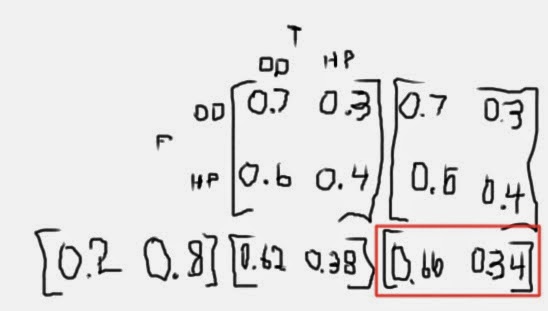If you don't know yet, matrices are basically tables of data that math people use to perform operations. Happy Easter!
~~~~~~
1) Somewhere over the rainbow, there's a place with really weird weather. Let's say that:
9 rainy days out of 10 are followed by non-rainy days.
3 non-rainy days out of 10 are followed by rainy days.
By that logic, what's the chance that any particular day will be rainy?
If we try to do it the hard way, we have to use the probabilities as a result of what the previous day is and therefore the day before that, and therefore the day before THAT, and on and on until we get lost in the past and we can't really be happy anymore. But the sequence HAS to converge somewhere! I think we both can figure out right now it's possible, and I wouldn't give you a trick question about this anyway.
Speaking of the past, you're feeling slightly nostalgic for high-school math classes. One topic seems to shout out at you in particular: network matrices. You remember that you can organize a huge network of different pathways using a single matrix, with each datum representing a number of pathways from one point to another.
Being a good little nostalgic person, you decide to do this for yourself.
So there you have it. You've managed to be a clean freak. What do we do now?
Let's say we know what the weather is today. Then we also know the weather probabilities tomorrow. And, by reapplying the probability matrix again, we can figure out the day after that! The matrix squared is:
0.76 0.24
0.72 0.28
So that's the probabilities for the day after tomorrow. We can do this again and again, so where does it converge?
[M]^30=
0.75 0.25
0.75 0.25
In this case, we can assume that 30 is an artificial infinity. Referring to this new matrix, we see that after "infinity," there is a 1/4 chance of sun. Since infinity can technically count as any random day, as any operation performed on infinity is nullified, we see that the chance that any random day will be rainy is exactly 1/4. Finally!
The cool thing about these transition matrices is that you can apply them to other data.
2) Two competing fast-food chains, O'Donald's and Hamburger Queen, have respective customer loyalties of 70% and 60%. If, when they open (at the same time), 80% of all customers go to Burger King, how many of the customers will go to O'Donalds after two trips?
So about 2/3 of the customers are going to O-Dees after two trips.
This repetition of matrices to find data is called a Markov Chain. Markov Chains are statistic models whose event probabilities are based on the previous event.
The matrix [(0.75, 0.25) (0.75, 0.25)] from the first problem is called a steady-state matrix, because it is the convergence of the transition matrix and cannot be altered further by the transition matrix.
Transition matrices and network matrices are used in a LOT of things: communication, business, competitions, ecology, psychology, transportation, and even biology.
~~~~~~~~
Crazy, right? I hope you like this as much as I do.
Stay coolio
John


No comments:
Post a Comment
Comment if you dare